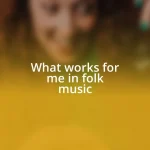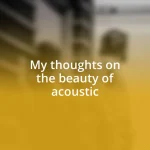Key takeaways:
- Ambient music’s roots trace back to pioneers like Erik Satie and the influence of minimalism from artists such as Steve Reich and Philip Glass.
- The genre evolved significantly in the 1970s with electronic experimentation led by artists like Brian Eno, followed by the merging of ambient with popular culture in the ’80s and ’90s.
- Key techniques for creating ambient sound include layering textures, using reverb and delay, and embracing silence to craft immersive listening experiences.

Understanding Ambient Music Roots
When I first stumbled upon ambient music, it felt like uncovering a hidden world. Its roots can be traced back to pioneers like Erik Satie, whose “furniture music” concept encouraged listeners to embrace sounds as part of their environment, rather than forcing them to focus on structured notes. Isn’t it fascinating how this approach invites us to appreciate the textures of sound that often go unnoticed in our busy lives?
Alongside Satie, the influence of minimalism in the 20th century played a crucial role in shaping the atmospheric soundscapes we now cherish. Artists like Steve Reich and Philip Glass laid the groundwork for gradual changes in music that invite deep listening. I remember my first experience with Reich’s “Music for 18 Musicians”; it felt like a sonic tapestry that wrapped around me, creating a vast emotional landscape. How often do we stop to really let music wash over us in such a way?
Moreover, the 1970s saw a surge in electronic experimentation that further defined ambient music. Brian Eno’s groundbreaking work, particularly his album “Ambient 1: Music for Airports,” encapsulated the serene yet unsettling nature of modernity, altering the way we interact with sound. Have you ever found yourself lost in an Eno track, where time seems to stretch and all your worries fade? For me, these moments reveal just how profound the roots of ambient music are in connecting us with our inner selves.

Exploring the Evolution of Ambient
The evolution of ambient music is a journey rich with transformation and innovation. As I dove deeper into this genre, I marveled at how it embraces a multitude of influences over the decades. Take the ’80s, for instance, when artists like Tangerine Dream and Vangelis merged electronics with film scores, producing lush soundscapes that could tell stories without words. I remember watching “Blade Runner” for the first time, completely entranced by Vangelis’s score; it felt like I was being transported to a different world where sound was the main character.
In the ’90s, ambient music began to intertwine with various cultural trends, such as the rise of chill-out rooms in raves. This era brought forth acts like The Orb and Moby, who creatively blended ambient sounds with dance beats. I recall my first experience in a chill-out room; after hours on the dance floor, it was the refuge I needed. The ambient tracks provided a feeling of buoyancy, as if I were floating away from the chaos, reconnecting with my senses.
Transitioning into the 21st century, we see ambient music experiencing a renaissance through digital platforms, making it accessible to a broader audience. Artists like Sigur Rós and Max Richter are redefining the boundaries of the genre, encouraging listeners to explore new emotional depths through sound. When I put on Richter’s “Sleep,” I often find I drift into a meditative state, reflecting on the power of sound in shaping our experiences. This evolution highlights how ambient music continues to grow, inviting new generations to engage with its tranquil yet profound nature.
| Time Period | Key Artists |
|---|---|
| 1930s – 1960s | Erik Satie, Steve Reich, Philip Glass |
| 1970s | Brian Eno, Tangerine Dream |
| 1980s | Vangelis, Harold Budd |
| 1990s | The Orb, Moby |
| 2000s – Present | Sigur Rós, Max Richter |

Key Artists in Ambient Genre
When I think about the key artists in the ambient genre, a few names come to mind that truly shaped its landscape. One standout for me is Brian Eno, whose innovative approach makes his music feel like a breath of fresh air. I distinctly remember the first time I played his track “Apollo: Atmospheres and Soundtracks” while gazing at a starry sky; it felt as if each note was a star illuminating my thoughts. His ability to create expansive soundscapes becomes a bridge between inner reflection and external wonders.
- Brian Eno: The pioneer of ambient music, known for albums like “Ambient 1: Music for Airports.”
- Tangerine Dream: Their use of synthesizers created ethereal journeys, with “Phaedra” being a prime example.
- The Orb: Merging rave culture with ambient, their track “Little Fluffy Clouds” brings nostalgic sensations.
- Sigur Rós: Fusing post-rock with dreamy elements, their ethereal sound can evoke intense emotions, as I experienced while listening to “Sæglópur” during a quiet evening.
- Moby: His early works blended ambient with electronic influences, making pieces like “Porcelain” resonate deeply in moments of introspection.
Another artist who captivates me is Max Richter. His composition “Sleep” has been my go-to meditation soundtrack, often bringing me to a place of tranquility I didn’t know existed. I recall a rainy afternoon, curled up with a book, when his music wove in and out, making the mundane feel sacred. The way he intertwines classical elements with ambient textures allows listeners to embark on a personal journey that feels both familiar yet profoundly new. It’s comforting to know these artists continue to shape how we understand and appreciate ambient music today.

Techniques for Creating Ambient Sound
Creating ambient sound is an art form that often requires a mix of intuition and technique. I’ve always found that layering different sound textures can invoke powerful emotional responses. For example, using soft synth pads alongside field recordings—like rustling leaves or distant waves—helps to establish a rich auditory tapestry. It’s like painting, where each sound adds a layer to the overall atmosphere.
One technique I enjoy is experimenting with reverb and delay effects. I remember the first time I used a long reverb on a simple piano melody; it felt like the notes were cascading into infinity. This approach allows sounds to blend seamlessly, crafting an immersive experience where the listener can lose themselves. Have you ever felt like time stands still while enveloped in sound? That, to me, captures the essence of ambient music.
Another essential technique is the use of generative processes, which can lead to unexpected, evolving soundscapes. When I started applying algorithms to create evolving patterns, it felt like I had opened a door to a whole new world of creativity. The unpredictability kept me engaged, almost like watching nature unfold in real time. Embracing these techniques can truly transform your ambient compositions, taking them from simple melodies to profound journeys.

Choosing the Right Instruments
When it comes to choosing the right instruments for ambient music, I believe it’s crucial to first connect with sounds that resonate with you personally. I remember my excitement when I experimented with a new soft synth, SynthMaster, which instantly transported me into a serene sound world. The lush pads and evolving textures it offered sparked countless ideas, reminding me that the right instrument can be a true extension of your creative voice.
I find that incorporating acoustic instruments can bring a unique warmth to ambient pieces. For instance, I once recorded the gentle strumming of my acoustic guitar, adding a layer of organic depth to an otherwise digital soundscape. Have you ever noticed how a simple guitar line can evoke memories or feelings in a way that purely electronic sounds sometimes can’t? This blending of the organic with the synthetic creates a richness that invites listeners to truly immerse themselves.
Lastly, don’t underestimate the power of unconventional instruments. I once stumbled upon an old kalimba in a thrift store, and using it added an enchanting whimsy to my compositions. Its bright, resonant tones brought a playful energy that I hadn’t experienced before. It’s amazing how diversifying your palette can open up entire new avenues of creativity. So, when selecting your instruments, consider what stirs your emotions and inspires your journey into the depths of ambient sound.

Crafting an Immersive Listening Experience
To create an immersive listening experience, it’s vital to focus on the dynamics of sound progression. I remember a night spent layering soft textures with subtle crescendos; the sensation was like a gentle sunrise breaking over a still horizon. This gradual build-up can take listeners on an emotional journey, capturing them in a serene embrace. Have you ever felt a single note rise and fall, almost like breathing? That interaction invites a connection between the music and the listener, allowing for reflection and relaxation.
Another key component involves the spatial placement of sounds. When I learned how to utilize stereo imaging effectively, it opened a new dimension in my compositions. Imagine the feeling of sounds moving around you, creating a three-dimensional auditory landscape. I often experiment with placing certain elements slightly off-center to enhance that sensation. Doesn’t it feel almost otherworldly when sounds seem to wrap around you, drawing you deeper into the ambiance?
Engaging with silence is also an important aspect of crafting an immersive experience. There’s a profound beauty in knowing when to let sounds fade. During one session, I intentionally introduced silences after rich passages, allowing the mind to absorb what was heard. It reminded me that sometimes, it’s in the space between notes that we find clarity. Have you ever sat in silence after a beautiful piece of music, letting the echoes linger? That’s where true connection with the sound happens.

Personal Reflections on Ambient Journey
I’ve often found that my ambient journey isn’t just about the sounds I create but also the feelings they evoke. One evening, as I sat surrounded by flickering candles, I played a piece that wound through my mind and heart like a gentle stream. It struck me then; the music mirrored my surroundings, reflecting the warmth and stillness, reminding me that creating ambient soundscapes often feels like sharing a part of my soul. Have you ever experienced this deep connection, where the music becomes an extension of your emotions?
Reflecting on my journey, I can’t help but recall the moments when experimentation led to unexpected revelations. For instance, while crafting a sound piece, I accidentally recorded my cat purring in the background. Instead of cutting it out, I wove it into the track, and that delicate layer transformed everything. It brought a touch of authenticity and warmth, allowing me to invite listeners into my world. Does your creative process lead you down unexpected paths too?
As I continue to explore ambient music, I realize that it’s also a journey of self-discovery. Each session reveals new aspects of myself, like peeling back layers of an onion. Recently, I discovered how certain sounds resonate with my childhood memories of lazy summer afternoons. This personal connection transforms not just the music but also the listener’s experience. Can you recall a sound or song that tugs at your own heartstrings? It’s moments like these that remind me how deeply intertwined our life experiences are with the art we create.














